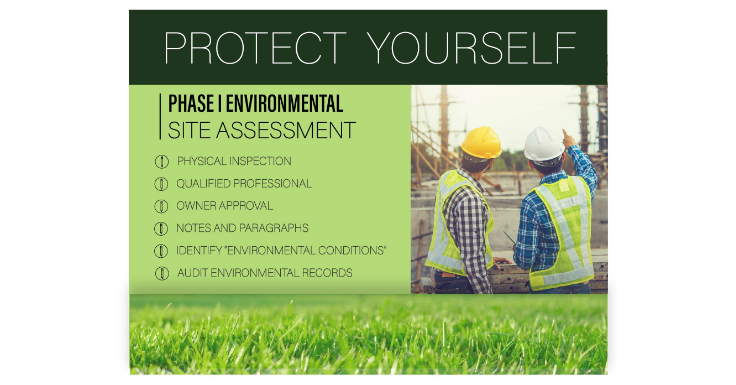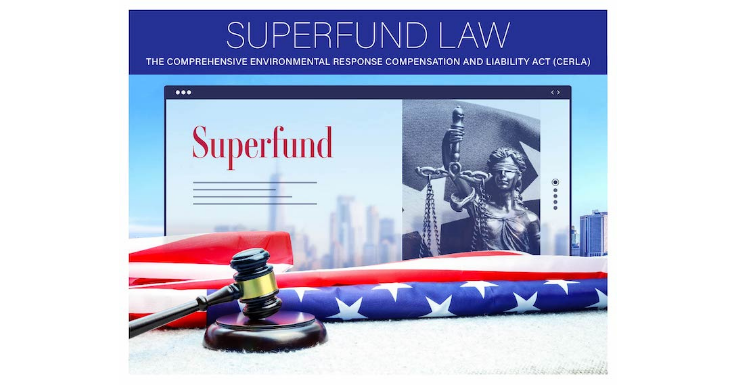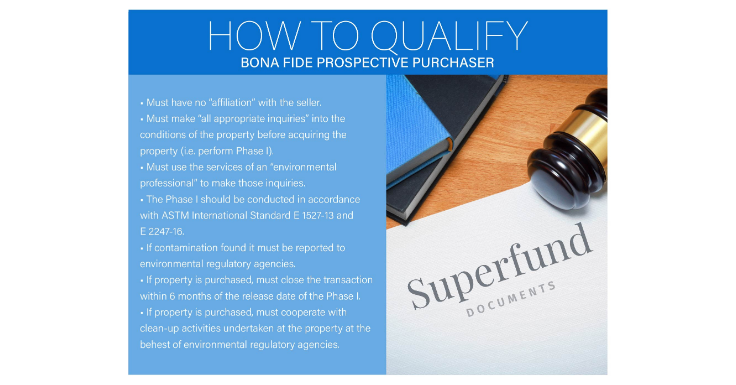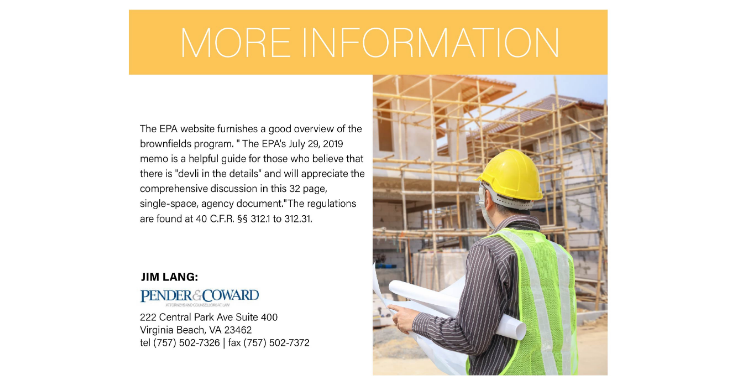
Get A Phase I Environmental Site Assessment Before Purchasing Commercial, Industrial or Agricultural Real Estate
Do not skip the Phase I (unless you like to live dangerously)
You found a property that aligns with the strategic plan for your business. Now, before time runs out in the “study period” provided in the sales contract, you are trying to decide whether to get a Phase I Environmental Site Assessment (“Phase I”). If you skip over this important step, you leave open the possibility that, unbeknownst to you, the property is contaminated with hazardous substances, hazardous waste or hazardous materials are present at the property. Learning this unhappy news for the first time after closing on the purchase can bring on a heavy case of buyer’s remorse.
If you buy the property without getting a Phase I, you might, for example, learn post-closing that non-obvious subsurface environmental contamination in the soil and/or in the groundwater prevents you from building the structure that was the central motivating purpose for entering the transaction. You might also discover underground contamination that means you are now stuck with a property that you can sell only if you accept a price far lower than the price you paid to acquire the property in the first place.

The structure at the property that you planned to remodel may hold asbestos containing materials (ACM) or lead based paint (LBP), in which case the remodel of the facility will now trigger a cost growth that takes the project outside budget. Even worse, an environmental regulatory authority might determine that an expensive clean-up is needed to remediate pollution at the property and you as the new owner are responsible to pay the entire bill because of the Comprehensive Environmental Response, Compensation and Liability Act (commonly known as “CERCLA” or the “Superfund Law”)!
The Superfund Law and the “bona fide prospective purchaser”
The key point to remember is that the buyer who qualifies as a “bona fide prospective purchaser” is protected from Superfund owner/operator liability.
Here is why this matters . . .
“CERCLA” or the “Superfund Law”, 42 U.S. Code §§9601 to 9675, was enacted in 1980 for the purpose of cleaning up leaking hazardous waste disposal sites. One specific section in the law, 42 USC §9607(a), creates a vast open-ended liability for cleaning up environmental contamination. No matter who put the hazardous substance at the property, no matter when the hazardous substance was put there, no matter whether it was perfectly legal to put the hazardous substance there at the time when it was done, 42 USC §9607(a) makes all the following persons liable for the full cost of cleaning up the environmental contamination caused by the presence of the hazardous substance at the property:
- The person who currently owns the property (the contract seller in the example described in the introduction, but the contract purchaser inherits this role if he or she closes on the transaction);
- The person who owned the property when the hazardous substance was put there;
- The person who generated the hazardous substance; and
- Any person who helped transport the hazardous substance to the property.

CERCLA made people reluctant – no, it made them terrified – to purchase contaminated property because doing so exposed them to the potentially ruinous cost of remediating the contamination. Contaminated properties came to be known as “brownfields” and they sat idle. Congress responded in 2002 by changing CERCLA in a way that shields the “bona fide prospective purchaser” from CERCLA owner/operator liability, but only if the purchaser qualifies as a “bona fide prospective purchaser”. The purpose in changing the law was to get brownfields back into productive use. The 2002 amendments also created a grant program as a further tool to encourage reutilization of brownfield sites. Note that “bona fide prospective purchaser” status does not insulate the purchaser from liability that a landowner may have under state statutory or common law, state or other federal agency claims under CERCLA, or private party claims under CERCLA. Still, by removing the specter of owner/operator liability, the “bona fide prospective purchaser” status provides a great deal of protection for the prospective purchaser.
How to qualify as a “bona fide prospective purchaser”
These are eligibility requirements that the purchaser must satisfy to gain “bona fide prospective purchaser” status:
- Must have no “affiliation” with the seller
- Must make “all appropriate inquiries” into the conditions of the property before acquiring the property (i.e. perform Phase I)
- Must use the services of an “environmental professional” to make those inquiries
- The Phase I should be conducted in accordance with ASTM International Standard E 1527-13 and E 2247-16
- If contamination found it must be reported to environmental regulatory agencies
- If property is purchased, must close the transaction within 6 months of the release date of the Phase I; and
- If property is purchased, must cooperate with clean-up activities undertaken at the property at the behest of environmental regulatory agencies

What is a Phase I, how long does it take, how much does it cost?
The Phase I should be prepared by an appropriately credentialed consultant who will conduct a document search of environmental and other databases, interview owners (past and present) and other persons with knowledge of property conditions, and make an in-person site visit to the property. The findings in the Phase I report will describe the uses to which the property has been put over time along with an assessment of environmental conditions at the property. This is a paper records search only. No environmental samples are collected, and no laboratory testing is performed (these are the purview of the Environmental Site Assessment Phase II study).
The environmental conditions in a Phase I will be described in terms of a “Recognized Environmental Condition” or “REC” (ASTM E 1527-13 describes a REC as “the presence or likely presence of any hazardous substances or petroleum products in, on, or at a property”), a “Controlled Recognized Environmental Condition” or “CREC” (ASTM E 1527-13 describes a CREC as “a recognized environmental condition that involves a past release of hazardous substances or petroleum products that has been addressed to the satisfaction of the applicable regulatory authority, with hazardous substances or petroleum products allowed to remain in place subject to required controls”), and a “Historical Recognized Environmental Condition” or “HREC” (ASTME 1527-13 describes HREC as “a past, regularly reported, release of any hazardous substances or petroleum products that has occurred in connection with the property and has been addressed to the satisfaction of the applicable regulatory authority or meeting unrestricted residential use criteria established by a regulatory authority, without subjecting the property to any required controls”).
The typical Phase I will be completed in 2-3 weeks. If, however, the consultant encounters difficulty in finding people with knowledge in order to conduct the interviews, it will lengthen the time needed to complete the Phase I. Similarly, if the consultant must issue a Freedom of Information Act request to obtain documents, typically from environmental regulatory agencies, any delay in the receipt of these documents can delay the issuance of the Phase I report.
The cost for a Phase I on a small, simple site may be as low as $2,000.00. Larger sites drive the cost higher, typically in the range of $5,000.00 to $6,000.00. A farm field would often fall at the lower end of this price range and a large site with warehouses would typically price out at the higher end of this range.
Resources for further reading
The EPA website furnishes a good overview of the brownfields program. The EPA’s July 29, 2019 memo is a helpful guide for those who believe that there is “devil in the details.” They will no doubt appreciate the comprehensive discussion in this 32 page, single-spaced, agency document. The regulations are found at 40 C.F.R. §§ 312.1 to 312.31.

Contact Jim Lang if you would like to see him publish more information on CERCLA, Superfund, Brownfields, or Environmental Site Assessments in the state of Virginia. Of course, you can always contact Jim for his advice and assistance in connection with any specific needs in your particular real estate acquisition.
